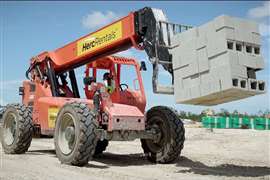Full of promise
20 March 2008
Figures for present and future construction projects in the Middle East make staggering reading. It is estimated that projects worth US$4 billion are being announced every week. There are 1,400 ongoing projects in the Gulf region, valued at around US$697 billion. The United Arab Emirates accounts for 32% of the projects (worth US$221 billion) and Saudi Arabia for 21% (worth US$146 billion). Total construction spend in the region is running at US$294 billion. In the UAE alone, 30,000 construction cranes (equal to almost 25% of the estimated 125,000 working globally) are in operation, 16% of those just in Dubai. Little wonder that the residents of the Emirate jokingly describe the crane as their national bird.
And still the area is yet to realise its full potential. Over the last two decades there has been a consistent increase both within the public and the private sector building projects - mosques, fire stations and schools alongside hotels, leisure and commercial developments, shopping malls and apartment blocks. At the centre of all this development is Dubai, which could be described as the world's largest construction site. The Emirate boasts the world's tallest and only seven star hotel, an indoor ski slope, a Manhattan-sized palm tree shaped peninsula that is visible from space, 300 man-made islands in the shape of the Earth, dozens of cities within cities and more than 50 ongoing projects, all with accompanying sub-projects.
The crane industry is thriving in the region in the face of such expansion, especially in Dubai where, for example, Manitowoc Crane Group has opened a new regional office, indicating, according to the company, its commitment to the booming region.
The new 1,400 m2 MCG facility in the Jebel Ali Free Zone includes sales offices, a workshop, parts warehouse and a training centre. The office will cover 20 countries, including the Gulf region, the Arab Near East, Turkey and most central Asian republics. According to the company, having one centrally located Middle Eastern office will give it the ability and flexibility to tailor a wide range of cranes to local requirements.
“The operations here have quickly evolved from several one man outfits to a central office with 30 employees,” says David Semple, Manitowoc Crane Group Middle East sales director and general manager. “By combining these resources we are able to more effectively and efficiently serve our customers throughout the region.”
“MCG is a global company with a strong commitment to local presence,” says Philippe Cohet, MCG executive vice president of the EMEA region. “We are consolidating our position to increase resources available to customers. I believe our growth puts us in a position of strength to tackle increasing demand and lead the way in this market.”
Spain-based tower crane manufacturer Comansa is also active in the Gulf region, and manufacturer of mobile and crawler cranes, Liebherr-Werk Ehingen in Germany, has reported spectacular success, delivering more than 50% of the total 130 all terrain cranes in 2005 in the Gulf States, and expecting a market share of 70% in 2007.
According to Hans-Georg Frey, former general manager of Liebherr-Werk Ehingen, the globally upward trend in the use of all terrain cranes is evident in the Gulf region, which he defines as the United Arab Emirates, Saudi Arabia, Qatar, Bahrain, Kuwait, Iraq, Oman and Iran.
The company has its own sales and service companies in Saudi Arabia, the Emirates and Iraq, with service branches in Jeddah, Riyadh, and Damman, Dubai and Baghdad. It operates agencies and service stations in Doha in Qatar, Kuwait City in Kuwait and Tehran in Iran, and is also represented in Oman, Yemen and Bahrain.
“From these locations we provide our customers with ongoing services in respect of the many and varied uses of our machinery in the region,” says Frey. “As well as the erection and removal of the many tower cranes, especially in Dubai, our routine business also covers crane applications in ports and on building sites in the petrochemical and other industries, such as the energy business, such as wind farms. Our customers operate in a wide range of sectors, and our mobile cranes are in constant demand.”
Mobile movement
The mobile crane business, especially in the UAE is driven by huge growth rates, says Frey, a particular feature of this being land reclamation schemes, such as three Palm Islands and the World Project.
“Another factor in this growth is the major investments in oil and gas production and processing and also in industrial plant such as steel and aluminium. The demand for mobile cranes is also positively influenced by the construction of traffic and transportation networks and investment in the tourist sector - hotel complexes and shopping centres.
“A major level of investment is expected in the oil and gas industry. Pipeline systems and refineries will continue their expansion. Land reclamation schemes will continue, creating more living space, as will traffic and transportation networks, such as the new airport in Dubai and there are reservoirs, drainage systems, effluent plants and pumping stations to be extended, renewed or constructed from scratch. Tourism too can expect further investment. The tallest tower in the world is currently under construction in Dubai and the Crystal Dome will also be one of the largest constructions in the world. Gigantic projects such as Hydropolis, the underwater hotel, are at planning stage and we have the railway lines to link the different emirates and Saudi Arabia. It is obvious we can count on a continuation of dramatic upward growth in this region. It almost goes without saying that this means a corresponding demand for mobile cranes.”
According to Kurt Rudigier, branch manager of Liebherr-Werk Nenzing in Dubai, other than Dubai, “the other important sales regions are the remaining Emirates of the UAE, plus Saudi Arabia, Kuwait and Iran. Overall there are more than 150 Liebherr duty cycle crawler cranes in use in the Gulf region.”
Crawler cranes are used mainly for foundation work and land reclamation projects, Rudigier says, and indicates three current projects as typical examples: the reconstruction of the Dubai Metro, and the two palm shaped land reclamation projects, the Jumeirah Palm and the Jebel Ali Palm.
The Metro entered the planning stage in 2002 and takes into account forecast traffic flows of 1.2 million passengers a day. Currently 18 km and 51 km of viaduct supported route are under construction. Construction began last year and a full service is scheduled for 2012. Liebherr duty cycle cranes will be used to excavate 54 m deep shafts with the HS 883 HD used to carry specially designed boring machinery and crawler cranes HS 853 HD and HS 855 HD used as supporting machinery.
Meanwhile the Jumeirah Palm Island project is in its final stages. Featuring space for thousands of villas and holiday homes, the reclaimed island had to be stabilised before construction could begin.
“For this, construction companies all over the world used 20 Liebherr duty cycle crawler cranes,” says Rudigier. “As for the Jebel Ali Palm, three Liebherr HS 895 HD models were in use. The Belgian construction group Jan de Nul used these machines for the construction of the 18 km-long breakwater.”
Elsewhere in the region the picture is much the same. In Saudi Arabia, plans are proposed for the $300 million expansion of the King Adulaziz international Airport in Jeddah, along with those for the construction of six “economic cities”, which will see billions of dollars spent on power, transport and water networks. Despite the fact that security concerns continue to undermine expansion in Israel and Iraq, and Iran's continuing refusal to reign in its nuclear expansion programme means the government runs the risk of economic sanctions, the region in general shows no signs of slowing down.






